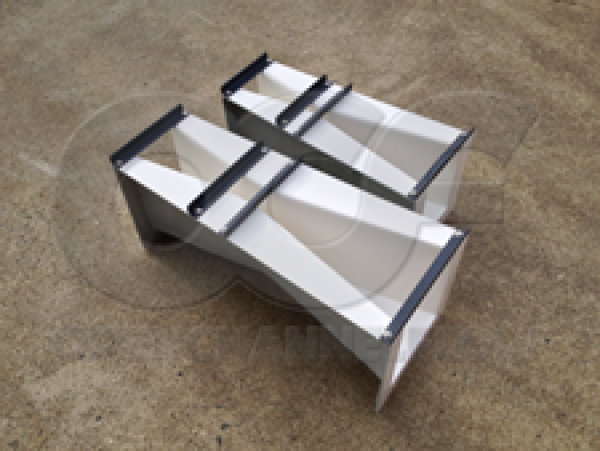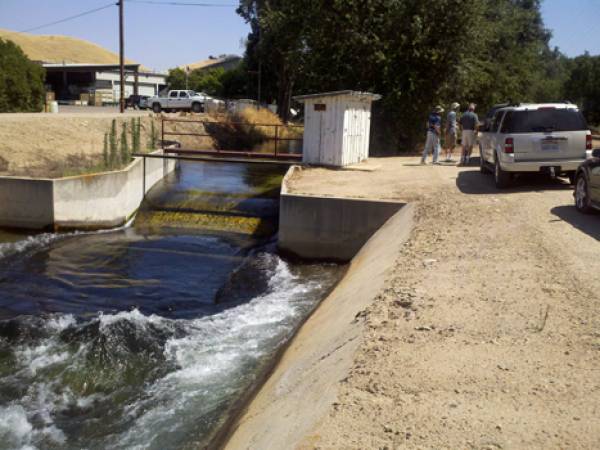This website uses a variety of cookies, which you consent to if you continue to use this site. You can read our Privacy Policy for
details about how these cookies are used, and to grant or withdraw your consent for certain types of cookies.
Calculating Parshall Flume Discharge
To calculate the discharge flow rate of a Parshall Flume several pieces of information are required:
- Flume size (Parshall Flumes are sizes by throat width)
- Head at the primary (Ha) and secondary (Hb) points of measurement
- Submergence ratio (secondary point of measurement head Hb / primary point of measurement head Ha)
- Whether the flume is experiencing free or submerged flow (as determined by the submergence ratio and flume size and submergence transition)

With this information and the appropriate free or submerged flow equation, the flow rate can be quickly calculated.
Note that this assumes that the flume is experiencing good approach conditions and that the flume has not settled or shifted out of position after installation.
Correcting for poor approaching flow conditions cannot be done numerically - the flow itself must be corrected. However, corrections for Parshall Flume settlement have been developed.
Flume Size
Parshall Flumes have an hourglass shape. The waist - or narrowest portion of the flume - is defined as the throat. As Parshall flumes have rigid, defined dimensions (per ASTM D 1941 and ISO 9826). So long as the flume conforms to these standards, the flume size can be checked by the throat width alone.
Ha and Hb Depths
Short throated flumes like the Parshall have defined locations for the primary (Ha) and secondary points of measurement (Hb). These locations can be found on the Parshall Flume Master Dimensions drawing.
Note that the zero reference level for both Ha and Hb is the floor of the inlet / converging section (even through the inlet for the Hb location is below this level).
Submergence Ratio
The submergence ratio of a flume is defined as the ratio of the downstream level (Hb) to the upstream level (Ha).
Hb/Ha
This ratio (Hb/Ha) is used to indicate the degree to which downstream conditions limit free flow out of the flume.
Submergence Transition
As Parshall Flumes increase in size, their resistance to the effects of downstream submergence increases.
| Size | Resistance |
|---|---|
|
1-3 inch Parshall |
50% |
|
6 inch Parshall |
60% |
|
1-8 foot Parshall |
70% |
|
10-50 foot Parshall |
80% |
Flow Equations
With the above known, the flow rate in the flume can now be calculated.
For free flow, the flow equation is:
Equation — Parshall Flume Free-Flow
Q = free flow rate (cfs / m3/s)
K = flume discharge constant (varies by flume size / system of units)
Ha = depth at the point of measurement (feet / meters)
n = discharge component (dimensionless, depends upon flume size)
K = flume discharge constant (varies by flume size / system of units)
Ha = depth at the point of measurement (feet / meters)
n = discharge component (dimensionless, depends upon flume size)
|
Throat Width |
K (Imperial) |
K (SI) |
n |
|---|---|---|---|
|
1” |
0.338 |
0.0479 |
1.55 |
|
2” |
0.676 |
0.0959 |
1.55 |
|
3” |
0.992 |
0.141 |
1.55 |
|
6” |
2.06 |
0.264 |
1.58 |
|
9” |
3.07 |
0.393 |
1.53 |
|
1’ |
4 |
0.624 |
1.522 |
|
1’-6” |
6 |
0.887 |
1.538 |
|
2’ |
8 |
1.135 |
1.55 |
|
3’ |
12 |
1.612 |
1.566 |
|
4’ |
16 |
2.062 |
1.578 |
|
5’ |
20 |
2.5 |
1.587 |
|
6’ |
24 |
2.919 |
1.595 |
|
7’ |
28 |
3.337 |
1.601 |
|
8’ |
32 |
3.736 |
1.607 |
|
10’ |
39.38 |
4.709 |
1.6 |
|
12’ |
46.75 |
5.590 |
1.6 |
|
15’ |
57.81 |
6.912 |
1.6 |
|
20’ |
76.25 |
9.117 |
1.6 |
|
25’ |
94.69 |
11.32 |
1.6 |
|
30’ |
113.13 |
13.53 |
1.6 |
|
40’ |
150 |
17.94 |
1.6 |
|
50’ |
186.88 |
22.35 |
1.6 |
For submerged flow, the flow equation is:
Equation — Submerged Flow
Q = discharge
Ha = depth at the point of measurement
Hb = depth at secondary point of measurement
W = throat width
nf = free-flow exponent
ns = submerged flow exponent
Cs = submerged constant
S = submerged ratio (Hb/Ha)
Ha = depth at the point of measurement
Hb = depth at secondary point of measurement
W = throat width
nf = free-flow exponent
ns = submerged flow exponent
Cs = submerged constant
S = submerged ratio (Hb/Ha)
For more information on the submergence equation.
Related Blog Posts
Explore more insights in our blog.

LOCATIONS IN ATLANTA, GA & BOISE, ID




